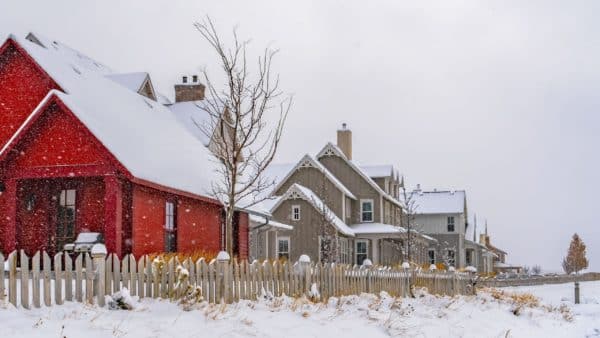How Winter Causes Indoor Air Quality Problems

How Winter Weather Wreaks Havoc on Indoor Air Quality
Winter weather can be the perfect excuse to enjoy time with friends or family indoors, but it can also affect the air quality in your home. It can lead to everything from damaged furniture to serious health issues, which is why it’s important to understand how colder temperatures outside can alter air quality inside, even when you have every window shut and crevice sealed. To protect yourself and your home, here’s a quick overview of how this happens and what to look out for.
Lower Humidity Levels
During wintertime, many people develop dry skin while staying indoors, and it’s a common misconception that this is caused by the use of furnaces or heat itself. This is normally a sign that indoor air quality has been compromised, and it’s typically caused by lower humidity levels, both inside and outside.
When the temperature of the air outside becomes colder, especially in northern climates where subzero temperatures can occur, it has a negative effect on the humidity where there’s less moisture in the air. This air outside then finds its way into homes where it affects indoor air quality by causing humidity levels to drop inside as well. Not only does this cause your furnace to work harder, which can result in premature wear and tear on a unit, but it also increases the risk of transferring respiratory illnesses from person to person inside a home.
Increased Pollutants
Winter also means more risk of indoor pollutants, whether it’s cigarette smoke or fumes from cleaning products. With everything sealed up and insulated, air circulation suffers, and this can lead to a buildup of pollutants in the air that would otherwise have escaped through vents or been filtered out by a well-maintained HVAC system.
You can’t just simply open a window or crack the door because this can also affect indoor air quality by allowing dry air in. Even otherwise harmless things, such as foul odors, can turn into big problems for homeowners. When poor air circulation causes odors to get trapped in a home, they can also become trapped in furniture and bedding and can then become a major issue that is difficult to remove.
Supplemental Heating Issues
Another issue relating to indoor pollutants during winter is the risk of carbon monoxide poisoning. Instead of using proper HVAC systems, many people use supplemental heat sources in their homes during the winter, such as wood or coal stoves.
These types of sources can pollute indoor air by creating carbon monoxide, which can be dangerous and even deadly in small confined spaces. Because we naturally spend more time indoors during winter and more attention is paid to ensuring that windows are closed and cracks are sealed, this can all lead to an accumulation of carbon monoxide, which might not be initially noticed or may result in headaches, cognitive issues, and other telltale signs of poisoning.
Although furnaces can also create carbon monoxide, they typically burn more efficiently than these other types of heat sources; however, they must be regularly checked and maintained to ensure that they are working as they should.
Mold, Bacteria, and Viruses
To keep a home warm and reduce heating costs during winter, it’s often recommended that you check your insulation to make sure every crevice and crack is sealed. However, because more insulation is being used, you can create an environment that allows bacteria, mold, and viruses to thrive.
Mold can develop virtually anywhere, including in HVAC or heater filters. Since colder temperatures can lead to round-the-clock heating indoors, mold spores have more opportunities to spread throughout the air, especially if a filter is being neglected and not regularly cleaned.
Viruses and bacteria have a tough time surviving in colder temperatures. A poorly ventilated home with a warmer air temperature than outside, however, is a perfectly suitable place for their survival.
Trapped Pet Dander
If you have pets, then you may have noticed increased signs of pet dander in the home during the wintertime. Those who have allergies may recognize this more quickly, as it can cause sneezing, itchy eyes, and a stuffy nose. Pet dander tends to build up in the air inside homes during winter for several reasons.
The main reason is that there’s typically less ventilation, with doors and windows remaining closed most of the time. Another reason is that many homeowners keep their pets inside to protect them from the cold weather or snow outside. In addition to spending more time indoors, pets may not be running around in a backyard or doing the regular activities that help to decrease dander by dispersing it outdoors instead of indoors.
Air purifiers and HEPA filters can help to reduce this dander indoors. It’s important to regularly inspect purifiers and filters because they often need more frequent cleanings during the winter months when they’re working harder to improve indoor air quality.
The Chimney Effect
There’s also a phenomenon known as “the chimney effect” or “the stack effect,” and whether you have a chimney or not, your indoor air can be affected by this in the colder months. When everything is sealed up inside a home, this can create a difference between indoor and outdoor pressure.
It can then create a vacuum effect where air is pulled in from outside, which can cause multiple issues. The air being introduced from outside is dryer, which in itself can affect indoor air quality. But while it’s entering the home, it can also carry with it many unhealthy pollutants from areas of the home that you don’t normally access.
Crawl spaces and attics, for example, may have asbestos or fiberglass insulation in them, and this air can carry fibers from these dangerous materials into the main living areas of a home. If you happen to have rodents living in tucked-away corners of your home, the air can become contaminated when it passes over their droppings as well.
Compromised Ductwork
Due to many of the previously mentioned issues, your HVAC ductwork may become compromised with debris, dust particles, mold, and other things that can continually affect indoor air quality. Once the air anywhere in your house has been affected by colder temperatures outside, a hard-working furnace must then work even harder to filter air, and the air ducts can then become dirty while the filter clogs. As the air continues to flow through these ducts, any dust, pollutants, or other things that have begun to accumulate within them can then be pushed back out into the living quarters of your house.
This is why it’s crucial to have your ductwork and vents checked by a qualified technician every three years or so. These types of issues can go unnoticed for quite some time until it starts to affect your health or your home.
Combat Poor Air Quality and Winter Weather Today
Regardless of whether you’re already noticing the signs of poor indoor air quality or would simply like to prevent these types of issues, we’re here to help. For HVAC maintenance or to learn about various air purifying products, Brennan Heating & Air Conditioning is the team to trust in the Seattle area. In addition to duct cleaning and indoor air quality solutions, we provide heating and cooling installation, repair, and maintenance. We also offer water heater and electrical services. Contact us today for more information or to set up an appointment.






